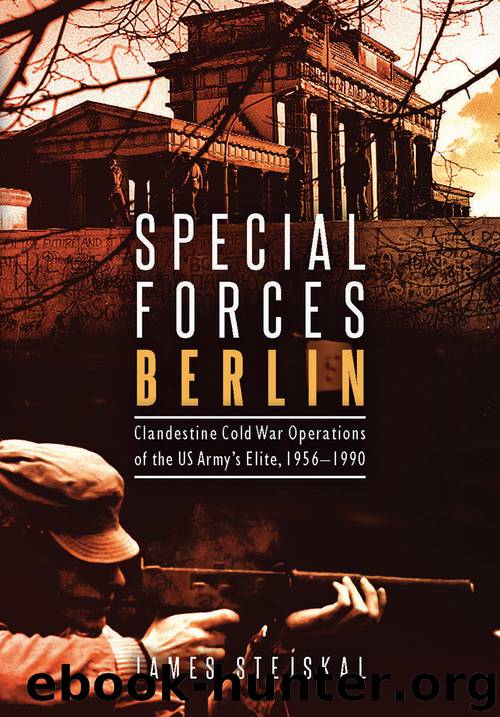Special Forces Berlin by James Stejskal

Author:James Stejskal
Language: eng
Format: epub
Publisher: Casemate
Published: 2017-04-08T04:00:00+00:00
The Ground Force Prepares
Until General Vaught stood in front of the assembled JTF in an Egyptian aircraft hangar on April 23, 1980 and announced that President Carter had given his “Go,” the plan was just that, a plan. It had yet to be approved by DOD and it had not been presented to the National Command Authority. This fact was important for a dual-mission unit like Det “A.” While a pure CT unit could focus exclusively on the Iran mission, the Detachment had continuous obligations that came with its UW mission. One of those obligations was to support USAREUR’s exercises, one of which was already on the calendar and would not go away.15
In the 1970s the Cold War was still on the minds of policy makers and the military. Massive exercises like REFORGER (Return of Forces to Germany) rehearsed the Allied plan to counter any Warsaw Pact aggression. In the special operations world, this contingency was practiced during FTX FLINTLOCK. Special operations forces from the US and other nations would jump, swim, and walk into simulated targets in Europe. It was a huge undertaking from a planning and logistics standpoint and one in which the Detachment traditionally played a large role.
But none of the men cared about that requirement once the Iran mission was known. Here was a mission reminiscent of Son Tay and no one wanted to miss out. No one spoke of risk or danger even though it was clearly a risky and dangerous undertaking. If it hadn’t been, no one would have clamored to go, just the opposite.
In the spring of 1980, one half of the unit’s “A” Teams were committed to FLINTLOCK, just when the commander and SGM needed to be able to look at every team member it had for possible deployment. Significantly, Teams One, Three, and Five were dedicated to the exercise that would take place in southern Germany in 1980 and, to avoid raising any suspicions, the SGM decided he would not make any changes to the roster.
The sole task other than FLINTLOCK that could pull members was the intelligence collection mission, for which MG and Scotty were already committed. Members of the Foreign Ministry assault element would be selected from members of the remaining teams: Teams Two, Four and Six.
This caused significant consternation among those who were tasked to support FLINTLOCK, especially as it became more and more apparent that EAGLE CLAW would actually happen. For once, no one wanted to participate in a four-week exercise and total immersion in Bavarian and Swabian culture. The dilemma was further exacerbated by the simple fact that the odd number teams had some of the most experienced personnel. Membership of Team One was almost wholly predicated on Vietnam service and most of the team had not only been SF in Vietnam, but in the Special Operations groups like Command and Control North (CCN). Team Five was also one of the better teams and had coalesced into a younger version of Team One with a highly effective team sergeant and team members.
Download
This site does not store any files on its server. We only index and link to content provided by other sites. Please contact the content providers to delete copyright contents if any and email us, we'll remove relevant links or contents immediately.
| Africa | Americas |
| Arctic & Antarctica | Asia |
| Australia & Oceania | Europe |
| Middle East | Russia |
| United States | World |
| Ancient Civilizations | Military |
| Historical Study & Educational Resources |
The Radium Girls by Kate Moore(11626)
100 Deadly Skills by Clint Emerson(4695)
The Templars by Dan Jones(4561)
Rise and Kill First by Ronen Bergman(4548)
The Doomsday Machine by Daniel Ellsberg(4250)
The Rape of Nanking by Iris Chang(4024)
Killing England by Bill O'Reilly(3899)
Hitler in Los Angeles by Steven J. Ross(3803)
Stalin by Stephen Kotkin(3728)
12 Strong by Doug Stanton(3420)
Hitler's Monsters by Eric Kurlander(3165)
Blood and Sand by Alex Von Tunzelmann(3060)
Darkest Hour by Anthony McCarten(3019)
The Code Book by Simon Singh(2864)
The Art of War Visualized by Jessica Hagy(2842)
Hitler's Flying Saucers: A Guide to German Flying Discs of the Second World War by Stevens Henry(2625)
Babylon's Ark by Lawrence Anthony(2433)
The Second World Wars by Victor Davis Hanson(2423)
Tobruk by Peter Fitzsimons(2376)
